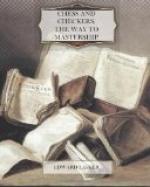+---------------------------------------+ 8 | | | | ^K | | | | | |---------------------------------------| 7 | ^Q | | | | | | | | |---------------------------------------| 6 | | | | | | | | | |---------------------------------------| 5 | | | | #K | | | | | |---------------------------------------| 4 | | | | | | | | | |---------------------------------------| 3 | | | ^B | | | | | | |---------------------------------------| 2 | | | | | | | | | |---------------------------------------| 1 | | | | ^B | | | | | +---------------------------------------+ a b c d e f g h
Diagram 78.—Problem No. 2.
Mate In Three Moves.
A favorite trick with composers is to provide a stalemate which they relieve by obstructing the way of one of the pieces involved in the stalemate. The move which is thereby allowed Black’s King exposes him to a discovered mate. The key move of problem No.3 is P-g8 (becomes Knight). After P-b5 Black is stalemate, but White relieves the stalemate by (2) Kt-e7, allowing Black to take the Knight on b4, and then mates by Kt-c6.
In trying to solve a problem it is a good method to examine Black’s moves first. Often it will be found that whatever Black moves White can mate in reply so that all that is necessary is to find a first move for White, which leaves the position unchanged as far as the different mating threats are concerned. If Black has one or more moves at his disposal in reply to which there is no mate, the way is indicated in which to provide for these defenses.
+---------------------------------------+ 8 | | | | | | ^B | | | |---------------------------------------| 7 | | | | | | | ^P | | |---------------------------------------| 6 | | #P | | | | | | | |---------------------------------------| 5 | | | | | | | | | |---------------------------------------| 4 | | ^Kt| | | | | | | |---------------------------------------| 3 | #K | ^P | | | | | | | |---------------------------------------| 2 | | | ^K | | | | | | |---------------------------------------| 1 | | | | | | | | | +---------------------------------------+ a b c d e f g h
Diagram 79.—Problem No. 3.
Mate In Three Moves.
In problem No. 4 for instance, it is evident that Black has to keep the two squares b8 and b4 guarded on which the Knight a6 threatens mate. Of course, Black can take the Bishop f5, relieving the mating threat but White can move the Bishop to some other square in the diagonal h3-c8. Still, Black would have the defense Q-f8. This suggests as White’s first move B-c8, interrupting the line from f8 to b8.




